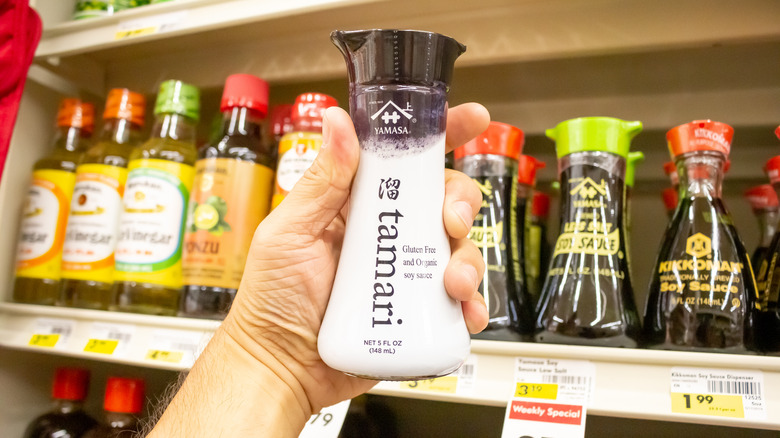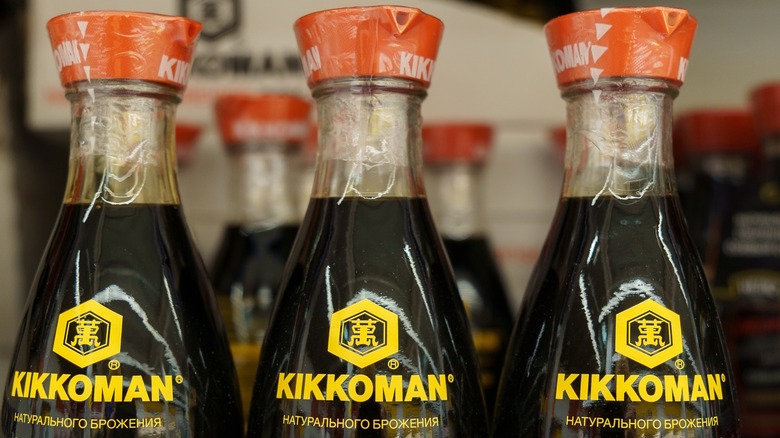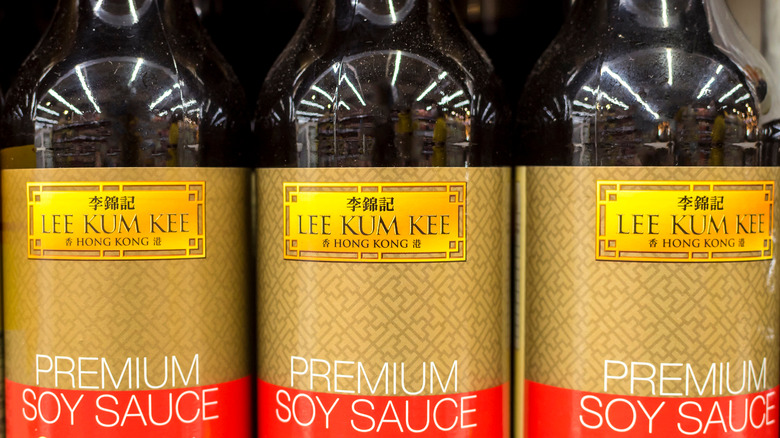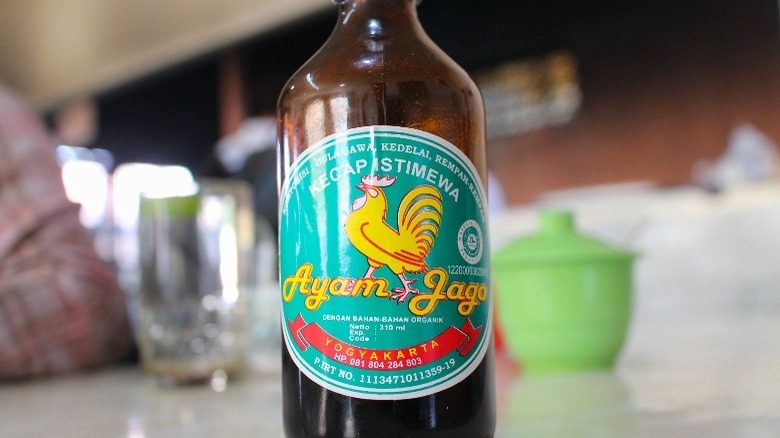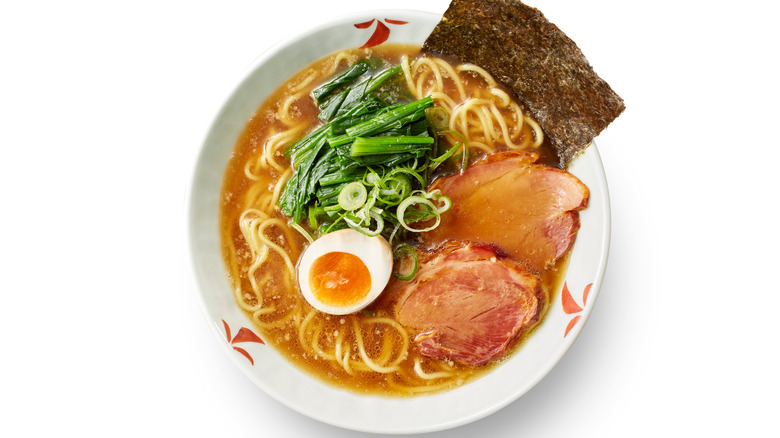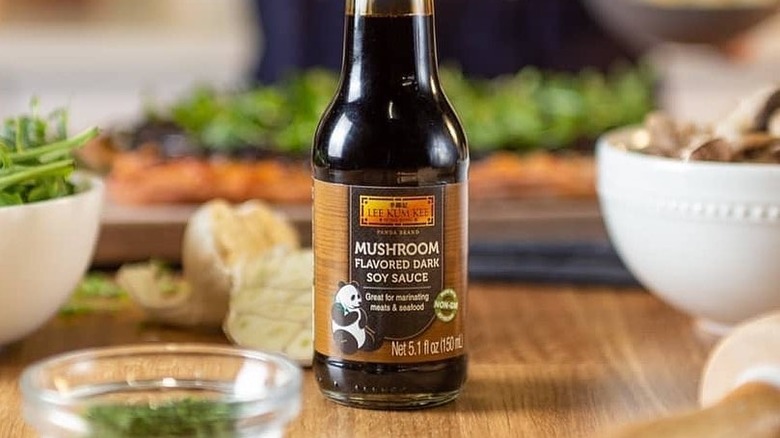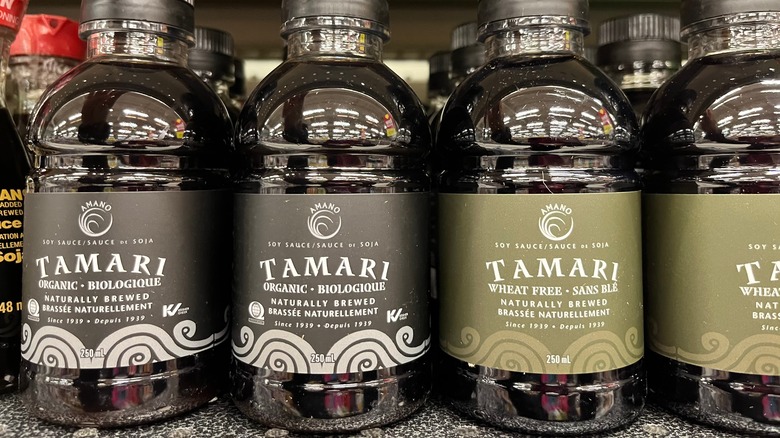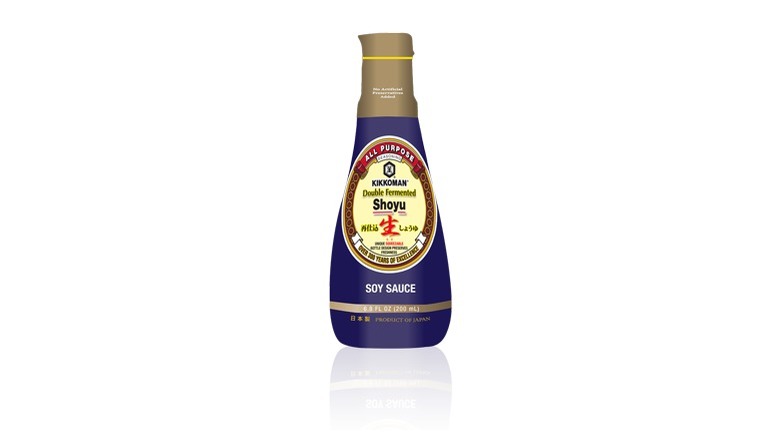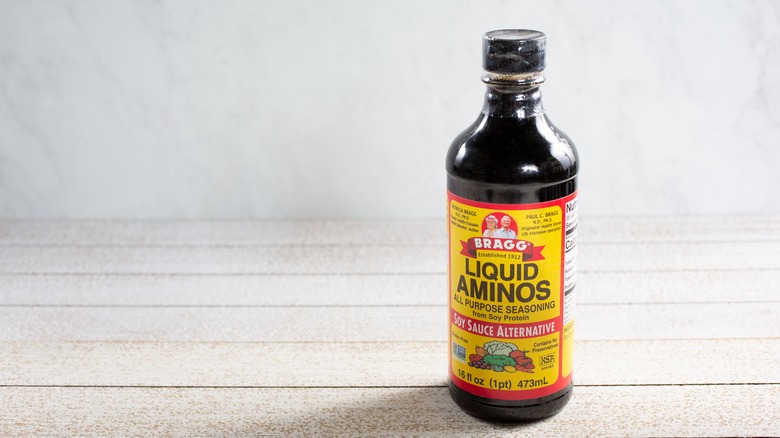8 Types Of Soy Sauce And Their Uses
If you grew up in America, your childhood memories of soy sauce are probably those little packets of brown liquid they tossed in the Chinese takeout bag. Maybe you used them; perhaps you didn't. They were largely an afterthought.
As you grew up and became an adult, so did America's Soy Sauce Horizons. Asian markets began to pop up in more and more locations. Food TV, magazines, blogs, and other media told us about the many different types. Amazon allowed myriad soy sauce types to be shipped directly to your door. Enter the rise of artisanal soy sauces.
It started in China in the fifth century B.C. with a fermented mix of soybeans, salt, water, and a benign mold called koji. Over time, soy sauce production spread across Asia, most notably in Japan. Japanese Buddhist monks brought soy sauce production techniques from China, and the Japanese made it their own — ultimately developing a soy sauce variant called shoyu. As a result, there's a lot to know about soy sauce, especially the wide different varieties. While they are largely interchangeable, some uses work better than others.
Japanese Soy Sauce
While the Japanese version of soy sauce called shoyu may not be the original, this style is probably the most prevalent in the United States, thanks to massive brands like Kikkoman. The most significant difference between Japanese soy sauce and the Chinese version derived from it is the addition of wheat to the fermentation mix.
Shoyu likely became the predominant form of soy sauce due to what it tastes like and its versatility. As a cooking ingredient, soy sauce can incorporate saltiness and heartiness — or umami — into a dish. As a table condiment, uncooked shoyu brings a range of earthy and floral notes to anything from steamed dumplings to sushi.
Those with dietary concerns should be aware of some specific shoyu qualities. People on a low sodium diet can opt for low sodium versions of shoyu, but these still contain significant amounts of sodium. Also, because shoyu is made with wheat and yeast, it is not gluten-free, and the brewing process does produce a low amount of alcohol. Those looking to avoid gluten or alcohol should choose another variety of soy sauces like tamari or liquid aminos.
Chinese Soy Sauce
Unlike popular Japanese soy sauces that use wheat, Chinese soy sauces tend to be mostly made from soybeans. When wheat is incorporated, it is typically wheat flour, not the toasted wheat used in Japanese-style sauce.
The heavier or complete use of soybeans results in a soy sauce that strongly resembles espresso in appearance and consistency. So-called "regular" Chinese soy sauce has a salinity similar to that of pickle brine, as well as a slight bean aroma, subtle sweetness, and deep umami flavor. It is best used in Asian braises and stir-frys, especially those with a deep umami flavor.
In addition to regular Chinese soy sauce, there are two other predominant styles (via Eater). A lighter version of Chinese soy sauce is used for subtle flavor additions. A darker version is thick and bold tasting. These variants are widely available in East Asia, but their availability is somewhat limited in the United States. However, internet merchants are changing that.
Sweet Soy Sauce
As the name suggests, sweet soy sauce takes the idea of soy sauce to a sweet extreme. Made with the addition of molasses or sugar, sweet soy sauce is used to add sweetness, saltiness, and umami to any dish. While they have differences in appearance and flavor, sweet soy sauce and oyster sauce can serve similar functions in a recipe.
Many Asian cultures use sweet soy sauce, but its use is strongly associated with Indonesian cooking. An Indonesian version of sweet soy called kecap manis is the country's most popular condiment (via Mashed). Kecap manis is mass-produced in Indonesia, and about 90 percent of all soy sauce made in the country is used to make it (via Daring Gourmet). Before industrial-scale productions, kecap manis was made by small-batch producers and available at local markets in Indonesia. In addition to being used as a dipping sauce, kecap manis is a key ingredient in popular Indonesian dishes like semur beef stew, nasi goreng, and ketoprak.
White Soy Sauce
While Japanese-style soy sauce is made from 50-50 blend of soybeans and wheat, white soy sauce strongly tips the balance in favor of more wheat. The result is a soy sauce that is sweeter and lighter than standard soy sauce. It's commonly used to maintain the light color of a dish like tonkatsu ramen.
According to Cook's Illustrated, white soy sauce — called shiro in Japan — is also made with a different production process than regular soy sauce. To make regular Japanese-style soy sauce, the soybeans are steamed, and the wheat is roasted before fermentation. To make white soy sauce, the wheat is steamed, and the soybeans are roasted. As a result, starch in the wheat turns to sugar, and fermentation of this preparation produces or sweeter, slightly more alcoholic end product.
White soy sauce is best used in dishes where soy sauce isn't meant to be the most dominant flavor. For example, it works well in stir-fries because aromatics like ginger and garlic are so integral to the overall flavor profile. The more delicate flavors of white soy sauce also lend themselves well to sushi, where raw fish is the star of the show. White soy sauce doesn't work well in dishes like chicken teriyaki, where the deep umami of regular soy sauce is essential.
Seasoned Soy Sauce
Regular old soy sauce can deliver a lot of umami to any dish, but those looking to add even more flavor per ounce should reach for seasoned soy sauce. There are countless ways to infuse soy sauce with additional flavor, including infusing it with ingredients like mushrooms or exposing it to smoke (via Mercury News).
Infused with straw or shiitake mushrooms, mushroom soy sauce is a popular seasoned soy sauce with a deeper, earthier flavor compared to regular soy sauce. This type of seasoned soy sauce is also thicker, and it works well in recipes that feature mushrooms, such as the signature P.F. Chang lettuce wrap recipe.
Called kunsei shoyu in Japanese, smoked soy sauce imparts an added depth of flavor to any dish, but it might be a bit overpowering for sushi and other delicate dishes. After a standard brewing process, kunsei shoyu is typically made by exposing soy sauce to the smoke of burning cherry wood (via Plant Based Matters). Because the smokiness from some of these sauces can be overpowering, blending them with regular un-smoked soy sauce can help tamp down the smoky flavor.
Tamari
Unlike soy sauce — which is made as the result of a dedicated production process — tamari is a byproduct of miso production. Because it isn't typically made with wheat, tamari is often marketed as a gluten-free alternative to soy sauce. However, some versions of tamari do contain trace amounts of gluten.
But tamari has a much broader appeal that comes down to what it tastes like (via Mashed). It typically has a lower salinity, and this gives it a more mellow flavor profile compared to soy sauce. Made almost entirely from soybeans, tamari ships stronger bean flavors and doesn't have the sharper, slightly alcoholic flavor of standard soy sauce.
As with other mild types of soy sauce, tamari is best used in recipes where the deep umami of soy sauce isn't the star of the show, such as in stir-frys. Tamari is also a great dipping or finishing sauce. Its subtle flavors are particularly well suited to sushi, poke, tempura, and cooked fish. You can use tamari as a life-for-like soy sauce replacement, but you may want to add salt to make up for the lower salinity unless you're watching your sodium intake.
Double-Fermented Soy Sauce
Saltwater is a main ingredient in standard soy sauce production. But what if you used soy sauce instead of saltwater? That's the idea behind double-fermented soy sauce. Soy sauce is mixed with koji mold before the fermentation process begins.
Called saishikomi shoyu in Japanese, double-fermented soy sauce is strongly associated with the southwestern regions of Japan, particularly the Yamaguchi prefecture. According to Kikkoman, saishikomi shoyu was invented in the 18th century and its popularity spread out from the bustling Yanaitsu Port.
Today, double-fermented soy sauce is considered a luxury item because it takes up to two years to produce. About 1 percent of all soy sauce production in Japan is double-fermented soy sauce. This more intensive production process levels up the umami of standard shoyu and gives the sauce added complexity. Because the nuance and complexity can be lost during cooking and because it is a premium product, double-fermented soy sauce is most often used as a table condiment for sushi, tofu, and other delicate dishes.
Liquid Aminos
Liquid aminos are very similar to soy sauce with some key differences (via Mashed). Rather than being made by fermenting cooked soybeans, liquid aminos are produced by soaking soybeans in an acidic solution that breaks down proteins in the beans. Sodium bicarbonate is then used to neutralize the acid, resulting in a liquid that strongly resembles conventional soy sauce.
Liquid aminos have several health benefits and some people prefer them as a healthier option in any recipe that calls for soy sauce. For one, liquid aminos contain 16 different amino acids, which are the building blocks of protein (via Healthline). They are also not made with wheat, which means liquid aminos are gluten-free. Liquid aminos, and Bragg Liquid Aminos in particular, have less sodium than standard soy sauce.
Even though liquid aminos strongly resembles soy sauce, don't count on them being in Asian food stores or the Asian food section of your local supermarket. Liquid aminos are often typically placed with seasonings, spices, vinegars, or health foods. Liquid aminos also tend to be more expensive than soy sauce.
